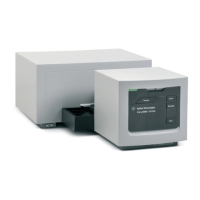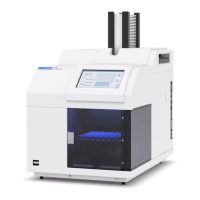35
Theory of Operation
Spectrophotometer Processor Main (SPM) Board
Main Microprocessor
The main microprocessor exchanges data with the ASIC through the core bus
as well as with the memory, consisting of the battery backed-up, non-volatile
random access memory (NVRAM), the system memory and the program
memory. The program memory includes the firmware which can be updated
by a download procedure from the computer. The battery for the NVRAM and
the real-time clock is designed to last for more than 25 years under normal
operating conditions.
Control lines provide communication to the SLS board, which in turn
controls the deuterium and tungsten lamps. The main microprocessor
comunicates to the SSP (spectra and signal processor) through a parallel bus.
ASIC—Application-Specific Integrated Circuit
The 304-pin application specific integrated circuit (ASIC) provides
interfacing to external devices through drivers, including GPIB, CAN, APG
Remote, and GPIO. It is also connected to the four control LEDs located near
the connectors on the SPM board and the 8-bit configuration switch which is
used to configure the address for the GPIB communication, baud rate for
RS232 transfer, and so on. For switch settings, refer to the Installing Your
UV-Visible Spectroscopy System handbook.
In addition it controls the shutter and cooling fan through the PWM (pulse
width modulation) driver. Operation of the cooling fan is sensed by the
microprocessor.
SSP—Spectra and Signal Processor
The spectra and signal processor (SSP) uses a dedicated ASIC and RAM of
3 × 128 KB and converts the 1024 raw data values from the SDA board to
intensity and absorbance values. Conversion and subsequent calculation to
achieve absorbance values include the following tasks, listed in the sequence
of processing:
1 dark current correction,
2 offset correction,
3 PDA temperature compensation,
4 stray-light correction,
5 absorbance calculation,
6 signal averaging (over integration time), and

